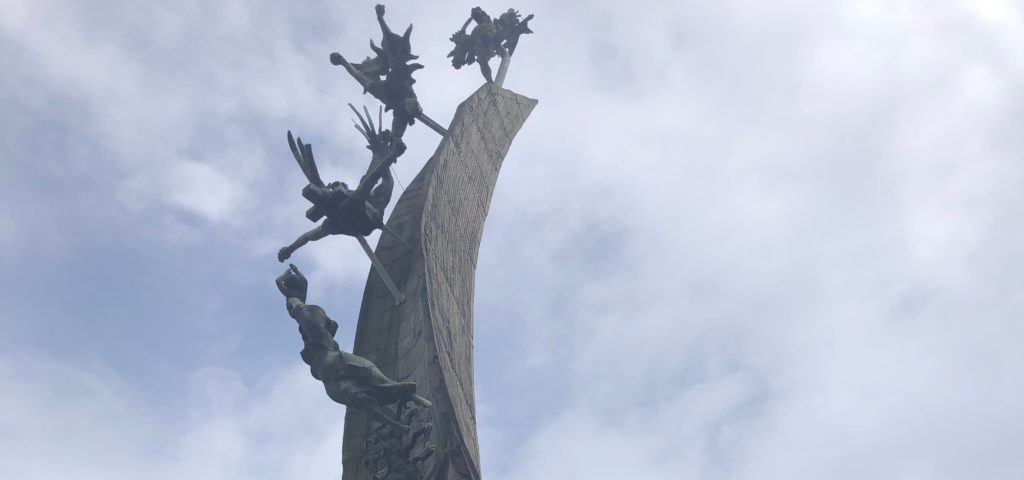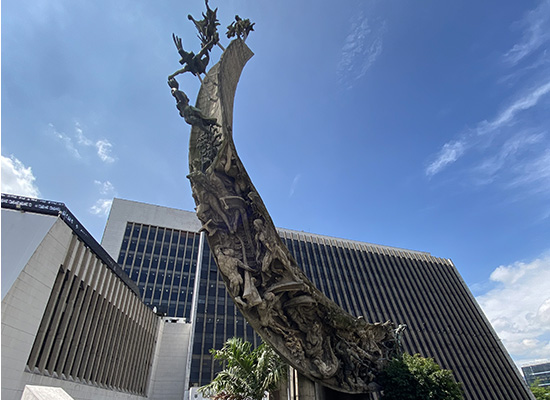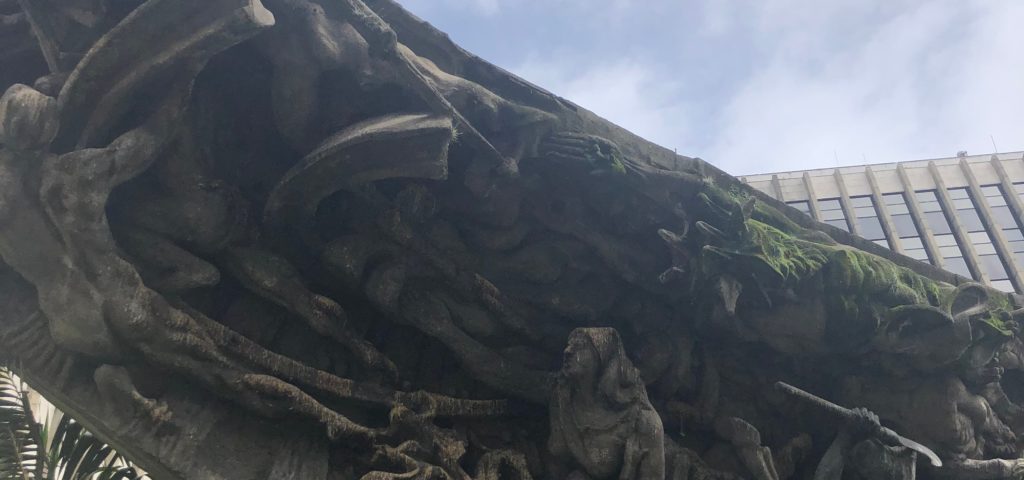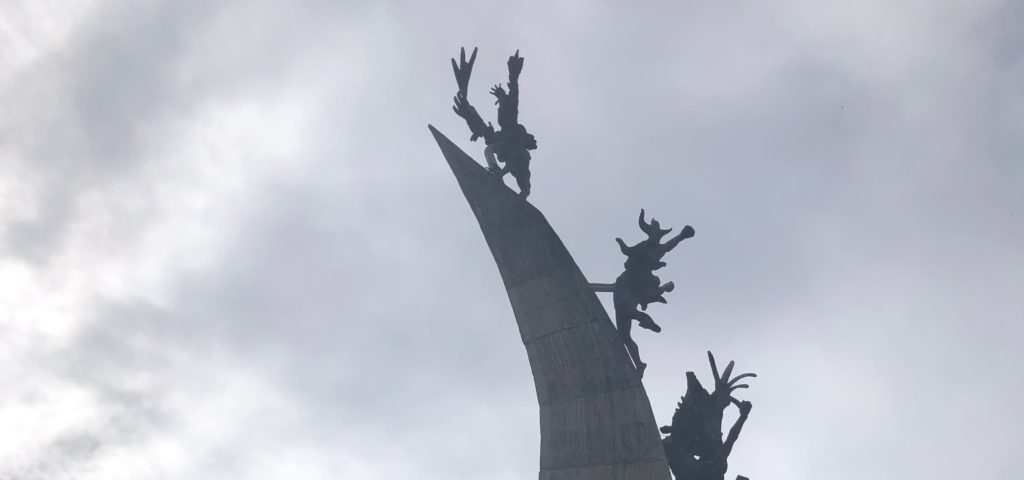Share this post:
Popular Posts
Visiting Medellin Recent Posts
Plan Your Trip Recent Posts
Living in Medellin Recent Posts
Greater Antioquia Recent Posts

TLDR? Monumento a La Raza is a statue in the middle of Medellin’s Plaza de La Libertad.
Monumento a La Raza is one of Medellin’s most well-known and highly revered works of public art. It lies in the center of the city amidst the highest offices of public administration, close to the Plaza de La Libertad.
The monument has become one of the symbols of the city, and its fine craftsmanship and iconic design have lent it a venerable and distinguished air.
The sculpture is the work of esteemed Colombian sculptor Rodrigo Arenas Betancourt. In my opinion, it should be considered a must-see by any fan of the fine arts who are visiting The City of Eternal Spring.
Here’s all the information I could muster on visiting when, where, and how!

Monumento a La Raza is about as central as it gets in Medellin it could be considered the most central object in the city. This is considering that it is in the center of the central plaza that connects all of the central administration buildings.
The monument is in a plaza known as Plaza de Libertad. As mentioned before, it connects some of Medellin’s main administrative and government offices right downtown.
If you’re staying in the downtown area, you’ll find yourself able to walk. Although, depending on exactly where you’re coming from, that could involve some chaotic moments. This is especially true if you’re crossing some of the busier boulevards of the city.
The metro is a decent choice, and you can get off at either the Cisneros stop on the B line or the Alpujarra stop on the A-line. Both of these bring you to a short jaunt to the monument.
A bonus is that if you do decide to walk to the monument, you’ll pass by quite several other attractions. Some of these include Escultura Montana, the Museo de Agua, the Plaza de La Libertad, and more!
So, it’s quite easy to work out visiting the sculpture by checking out several other fine attractions of Medellin.

Monumento a La Raza was made by one of Colombia and Latin America’s greatest sculptors, Rodrigo Arenas Betancourt, in 1988.
Betancourt created numerous works of public art for several Colombian cities. His pieces can be found decorating many of those places’ most iconic and important city spaces and institutions.
Betancourt was highly celebrated in his time and is considered one of Colombia’s most important artists. He’s perhaps behind only Fernando Botero in terms of public recognition.
The monument is crafted in concrete and plaster. This is slightly different than the bronze that Betancourt typically utilized in his creations.
It is a beautiful and chaotic mixture of scenes of pain and joy, the good and the bad of life. It’s all jumbled into a distinctive crescent shape that rises to over 100 feet at its highest point.
The craftsmanship is exquisite, and the design is quite thrilling and creative. So, I think the sculpture is a must-see if you’re even remotely interested in this kind of thing.

Betancourt considered Monumento a La Raza to be one of his most important and personal works. After his death, his ashes were placed beside the sculpture.
There is also a touching memorial to the sculptor adjacent to the sculpture that includes Betancourt’s hands molded in bronze. This is because it was his preferred medium to work with.
While researching the monument, I came across a quote from the Sculptor’s wife that spoke to the importance of Monumento de La Raza to Betancourt.
“He interpreted and made a concrete-and-bronze epic, where he told the history of Antioquia, like the jobs, the mythology, among others. This work is a horseshoe that is on a pedestal and inside the development, colonization, and Paisa history broadens”
The sculpture is intended to be a story of the history of Antioquia, and Latin America told in the form of figures. There are numerous figures, including animals and people of the past, all convulsing and engaging in a variety of activities.

Monumento a La Raza was created to honor an important concept in Latin America, that of the eponymous La Raza.
La Raza is an important concept in Latin America. It speaks to the period when the Spanish and other colonizers mixed blood with the indigenous peoples of the Americas. This process created the ethnic background of the modern Latin American identity.
The term is either slightly out of fashion or coming back into fashion, depending on who you talk to. For a long time, it was very popular in the 20th century.
In more recent years, the term was rejected in favor of others, such as Hispanidad. However, in a funny turn of events, the phrase has begun to find favor again with certain groups who find usefulness in it again. This includes the modern Chicano movement, for example.
Betancourt created the piece at a time when Colombia and Antioquia were undergoing intense hardship in the 1980s and 90s. It’s a far cry from the current cultural and economic boom that the country is currently enjoying.
The piece was intended to honor the power of the Antioquian identity. It does this while recognizing the sometimes brutal history of Latin America.
I found that investigating the background of Betancourt’s sculpture made me appreciate the artwork that much more. This is saying something since, in my opinion, it was already very impressive having known none of the historical or cultural contexts.
I also found that the Monumento a La Raza whetted my appetite to try and learn more about its creator. Rodrigo Arenas Betancourt would have to number amongst my favorite Latin American artists at this point.
I thought a fun thing to do would be to try most of his major works, which are peppered across the country in numerous locations. This would be especially true if you find yourself like me, a new fan and appreciator of Betancourt.
If you’re not like me and consider yourself just a casual fan of the arts, or just nice places to sit and think about life, you’ll still find a visit to the Monumento a La Raza to be well worth your time!
If you like this blog, you might like the Casacol Instagram page to keep up with all the new articles. Anything we need to update or correct? Care to contribute? Email us at blog@casacol.co.